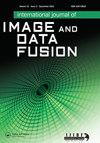A multi-sensor-based evaluation of the morphometric characteristics of Opa river basin in Southwest Nigeria
IF 1.3
Q3 REMOTE SENSING
International Journal of Image and Data Fusion
Pub Date : 2020-04-02
DOI:10.1080/19479832.2019.1683622
引用次数: 5
Abstract
ABSTRACT Studies have shown that many river basins in the sub-Saharan Africa are largely unmonitored, partly because they are poorly or totally ungauged. In this study, remote sensing products (Landsat, Advanced Spaceborne Thermal Emission and Reflection Radiometer; ASTER and Shuttle Radar Topography Mission; SRTM) that are freely available in the region were harnessed for the monitoring of Opa river basin in southwestern Nigeria. The remote sensing products were complementarily used with topographical sheets (1:50,000), ground based observation and global positioning systems to determine selected morphometric characteristics as well as changes in landuse/landcover and its impact on peak runoff in the Opa river basin. Results showed that the basin is a 5th order basin whose land area has been subjected to different natural and anthropogenic influences within the study period. Urbanisation is a major factor that threatens the basin with degradation and observed changes, and the threats are expected to become worse if restoration is not considered from some tributaries. The study concluded that commentary use of available remote sensing products in the region will provide an important level of decision support information for management and monitoring of river basins.基于多传感器的尼日利亚西南部Opa河流域形态特征评估
研究表明,撒哈拉以南非洲的许多河流流域在很大程度上没有受到监测,部分原因是它们很差或完全没有测量。在本研究中,遥感产品(Landsat,先进星载热发射与反射辐射计;ASTER和航天飞机雷达地形任务;该区域免费提供的SRTM)被用于监测尼日利亚西南部的奥帕河流域。遥感产品与地形片(1:50 000)、地面观测和全球定位系统相辅相成,以确定选定的形态特征、土地利用/土地覆盖的变化及其对欧帕河流域峰值径流的影响。结果表明,该盆地为五级盆地,其土地面积在研究期间受到了不同的自然和人为影响。城市化是威胁流域退化和观察到的变化的主要因素,如果不考虑从一些支流恢复,预计威胁会变得更糟。该研究的结论是,该地区现有遥感产品的评论使用将为流域的管理和监测提供重要的决策支持信息。
本文章由计算机程序翻译,如有差异,请以英文原文为准。
求助全文
约1分钟内获得全文
求助全文
来源期刊

International Journal of Image and Data Fusion
REMOTE SENSING-
CiteScore
5.00
自引率
0.00%
发文量
10
期刊介绍:
International Journal of Image and Data Fusion provides a single source of information for all aspects of image and data fusion methodologies, developments, techniques and applications. Image and data fusion techniques are important for combining the many sources of satellite, airborne and ground based imaging systems, and integrating these with other related data sets for enhanced information extraction and decision making. Image and data fusion aims at the integration of multi-sensor, multi-temporal, multi-resolution and multi-platform image data, together with geospatial data, GIS, in-situ, and other statistical data sets for improved information extraction, as well as to increase the reliability of the information. This leads to more accurate information that provides for robust operational performance, i.e. increased confidence, reduced ambiguity and improved classification enabling evidence based management. The journal welcomes original research papers, review papers, shorter letters, technical articles, book reviews and conference reports in all areas of image and data fusion including, but not limited to, the following aspects and topics: • Automatic registration/geometric aspects of fusing images with different spatial, spectral, temporal resolutions; phase information; or acquired in different modes • Pixel, feature and decision level fusion algorithms and methodologies • Data Assimilation: fusing data with models • Multi-source classification and information extraction • Integration of satellite, airborne and terrestrial sensor systems • Fusing temporal data sets for change detection studies (e.g. for Land Cover/Land Use Change studies) • Image and data mining from multi-platform, multi-source, multi-scale, multi-temporal data sets (e.g. geometric information, topological information, statistical information, etc.).
 求助内容:
求助内容: 应助结果提醒方式:
应助结果提醒方式:


